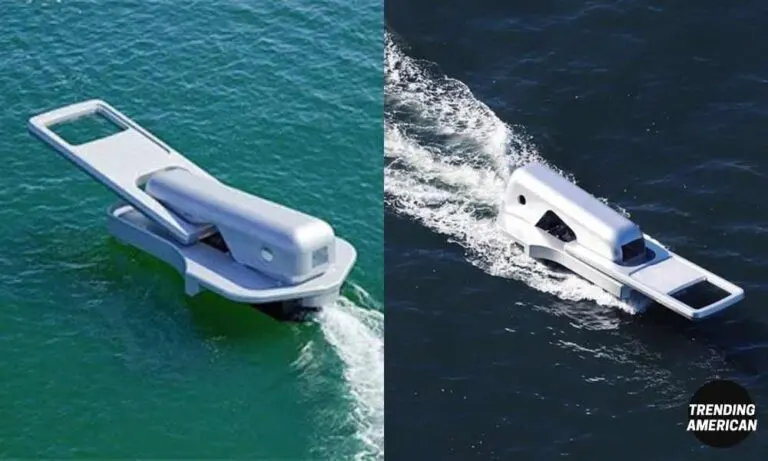A ‘Mini Dome’ House Designed In The Shape Of World’s First Atomic Bomb!
A groundbreaking new design concept in tiny homes has drawn inspiration from an unusual source: the shape of the world’s first atomic bomb. The creators call this the “Mini Dome” house. The tiny house models itself after the pentakis dodecahedron, a complex 60-sided geometric figure. The house is also the world’s first 60-sided home. Joshua Tulberg of Dodeca Domes is the mind behind the concept. More expert architects have collaborated and designed it to maximize the limited space and have efficiently used two floors. They have now transformed it into a symbol of modern engineering and sustainable living. The owners advertised it on Airbnb. The tiny house sits in Portland, Oregon, and can host two people. Let us find out more about this unusual design.
Mini Dome House | Shape of the World’s First Atomic Bomb
The shape of the world’s first atomic bomb, known as “The Gadget,” plays an important role in understanding the inspiration behind the Mini Dome. “The Gadget” was a spherical bomb with multiple surrounding facets. It was designed using precise geometric principles to house its internal components, including the plutonium core that would initiate the explosion. Specifically, 32 detonators were arranged in a carefully designed implosion system. These detonators compressed the plutonium core to a supercritical state, triggering a nuclear blast.
The intricate structure was necessary to create an even distribution of force around the bomb, ensuring its devastating efficiency. Scientists detonated the device on July 16, 1945, in the Trinity Test at the White Sands Proving Ground in New Mexico. The successful test paved the way for the later use of atomic bombs during World War II.

The Mini Dome’s pentakis dodecahedron design echoes this geometric precision. A pentakis dodecahedron is a polyhedron that consists of 12 regular pentagons, with 5 triangular pyramids attached to each pentagon. This creates a shape with 60 triangular faces. While the Mini Dome does not replicate “The Gadget” exactly, its multifaceted shape evokes a similar sense of balance and symmetry.

Building the Mini Dome
Dodeca Domes’ Joshua Tulberg built the Mini Dome. The Mini Dome’s creators wanted to offer an alternative to conventional housing. The structure’s bare hub kit form allows for customization, giving owners the freedom to adapt the dome to their specific needs. According to reports, the dome can be easily assembled using just a few tools, making it an ideal choice for off-grid living or anyone looking to simplify their lifestyle.
Each triangular panel is made from durable, weather-resistant materials that can stand up to the elements. The dome’s strength lies in its shape; the interconnected triangles create a rigid structure, allowing the house to be incredibly resilient despite its lightweight design.
Why a Geodesic Dome?

Buckminster Fuller popularized the Geodesic Dome in architecture. geodesic domes have interconnected triangles and, thanks to their unusual looks, are a popular choice with hobbyists for greenhouses and eco-homes. The use of a geodesic dome shape in tiny house designs is not entirely new, but the Mini Dome’s creators took this concept to another level with the pentakis dodecahedron.
Domes naturally maximize interior space while minimizing exterior surface area, making them more energy-efficient than traditional square or rectangular homes. The unique shape allows air and heat to circulate more effectively, reducing the need for artificial climate control.

The Mini Dome’s design also resonates with the minimalist movement, which values simplicity, efficiency, and sustainability. The house’s compact size encourages homeowners to downsize and focus on what matters, whether that’s reducing their environmental impact or simply living with fewer possessions.
Inside the Mini Dome
While the exterior of the Mini Dome is certainly eye-catching, its interior design is equally impressive. Despite its small footprint, the dome’s open-plan layout creates a spacious feel. Natural light floods the space through strategically placed windows, and the high ceiling adds to the sense of openness. The interior measures 308 sq ft (28 sq m) and is spread over two floors, with a very open layout. The front door opens onto the main living area. It has triangular windows.

The interior can be customized to suit the owner’s preferences. but most Mini Dome models feature a sofa bed and a dining table for two people. A large central unit serves as a kitchen, bathroom, and bedroom. Further, it hosts a TV for the living area. Focusing on the kitchen, this includes a fridge/freezer, a sink, a coffee maker, a microwave, a toaster, and a cabinet. The bathroom, meanwhile, has a shower and toilet (there’s also a hot tub outside).
You can reach the Mini Dome’s bedroom by a space-saving spiral staircase. In the bedroom, there is a simple mezzanine with a queen-sized bed. There appears to be plenty of space to stand upright, unlike the upstairs bedrooms in many tiny houses.

A Symbol of Innovation
The Mini Dome’s connection to the world’s first atomic bomb is not without controversy. For some, the bomb represents destruction and the darker side of human innovation. However, the Mini Dome’s creators have reimagined this symbol, turning it into a beacon of hope and progress.

Tulberg aims to sell the bare hub kit for US$15,000 in 2025.
Conclusion
The Mini Dome house is more than just a place of lodging—it’s a statement about the power of design and the potential for architecture to shape our world in unexpected ways. By drawing inspiration from the shape of the world’s first atomic bomb, the creators of the Mini Dome have transformed a symbol of destruction into one of sustainability and innovation. This tiny house is a reminder that even the most unlikely ideas can be reimagined for the better, offering a fresh perspective on how we live and interact with our environment.
The Sahara Desert Filled With Water After 50 Years!
Why Honey Never Spoils | Archaeologists Found 3000-Year-old Honey Pots That Are Still Edible!







